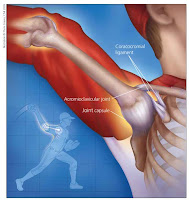For twelve years I’ve been sports chiropractic in West Hollywood. I’ve seen my fair share of shoulder injuries and conditions. The one I see most is shoulder impingement syndrome, and I find the element most forgotten in this common sports injury is the biceps tendon.
Now you might think, “Wait…my doctor told me I have biceps tendinitis, but it just never got better.” Right–because biceps tendinitis is only 33% correct when it comes to impingement syndrome. Two other elements play a major role in this sports injury–the supraspinatus tendon and the subacromial bursa–and so solely focusing on the biceps will not solve the problem.
However…when a shoulder impingement is properly diagnosed, and all instructions are followed, as far as treatment and icing is concerned, then the element I find most responsible for any stubbornness to healing and persistence of pain is the biceps tendon.
The final solution is two-fold. First is icing and cooling down that inflamed tendon. In the video below, I show the best way to ice the biceps tendon. It’s important to get the long head tendon out to the surface–you’ll get the most complete icing that way. To do this you will need to externally rotate the arm. I instruct my clients to do this seated in a chair or couch, or anywhere in which the arm can be help up and rotated outward. This movement brings the long head of the biceps from the deep interior of the axilla (arm pit) out to the exterior, and the back rest can be used to hold the arm in place, because remember icing should be done for fifteen minutes, no more, no less.
Watch the video to see how to best ice your biceps-persistent shoulder impingement syndrome, and we’ll discuss the second step in a future post.
















